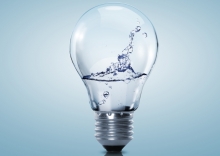Issue:
A patented titanium dioxide catalyst combined with use of ultraviolet light offers the potential for a chemical-free treatment for reducing micropollutants in wastewater discharges.
UK-based atg UV Technology has introduced a new technology that it sees as having potential to make a cost-effective contribution to efforts to remove micropollutants from wastewater discharges.
The new technology is called Keratox and was launched at the Aquatech Amsterdam exhibition in November last year. It features a patented titanium dioxide catalyst with a special crystalline arrangement. The catalyst is housed in cartridges which are then inserted within a treatment chamber containing standard low pressure amalgam UV lamps. The catalyst produces high levels of hydroxyl radicals, so that advanced oxidation treatment can be carried out without the use of chemicals such as hydrogen peroxide and ozone.
Barry Hopton, atg’s Municipal Sales Manager, explains that the company wanted to extend its UV expertise and noted the likely long term requirements of the EU Water Framework Directive and Priority Substances Directive. The innovation of Keratox provides an opportunity to do this. ‘The innovation also comes from the fact that it can be retrofitted into any existing UV plant,’ adds Hopton.
‘We are framing the Keratox product as a commercially-ready product in certain areas for certain contaminants, for example in the ultrapure market,’ says Hopton. Use of advanced oxidation processes for carbon removal is established for applications such as boiler feed water and semiconductor production. ‘It’s been very effective against total organic carbon, and we have got trials on at the moment in the nuclear sector that are proving that to be true,’ he adds.
The micropollutant opportunity is more complex. A few countries, such as Switzerland and Germany, have been moving forward with treatment at their wastewater plants. Trials are progressing around Europe looking further into the practicalities of removing micropollutants, including looking at the use of advanced oxidation processes. There are also many and diverse potential contaminants as far as hazardous substances, micropollutants and pharmaceuticals are concerned, with challenges also in terms of testing for such substances.
The company had been progressing with participating in trials. ‘We have kind of stepped back,’ says Hopton. ‘What we’ve come to realise is that, because there are so many of these micropollutants, hazardous chemicals and other pharmaceuticals on the watch list, we really need to get an understanding of what the performance is against these,’ he continues, adding: ‘We are probably about a year off actually having a fully commercial product for micropollutants,’ he says.
The micropollutant market is further complicated by the fact that the selection of technology is influenced by local conditions and by local preferences. Germany, for example, has been focusing on the use of activated carbon, while in Switzerland there is a still a conscious effort to test out different process combinations. ‘One technology is not likely to be a solution for all because of the different incoming qualities,’ says Hopton.
‘We understand that Keratox, from the point of view of treatment, may not be the only solution in the process chain,’ says Hopton, meaning that another step such as use of carbon may be needed. ‘We don’t think that in terms of actual [removal] performance it will be the best on the market, but what we do think is that in relative performance terms it will be sufficiently cheaper in capex and opex compared to a lot of other technologies.’
Keywords:
- UK, atg UV Technology, micropollutants, municipal wastewater, sewage






